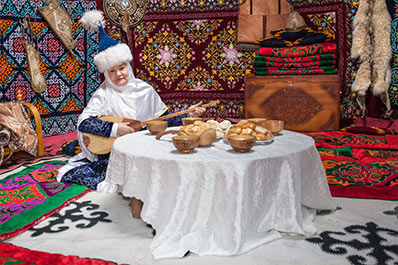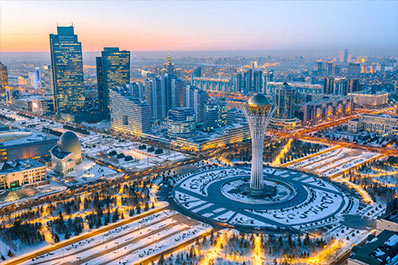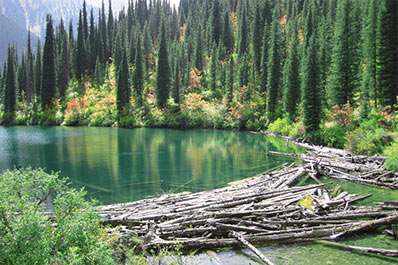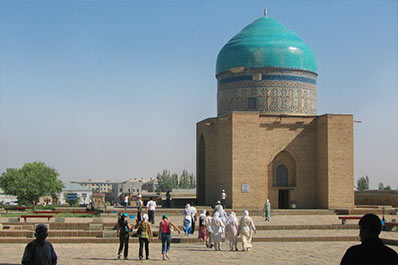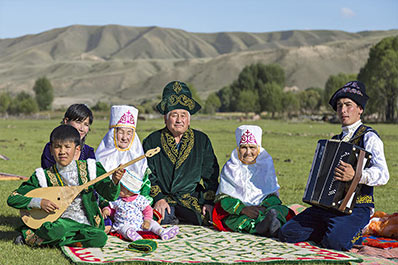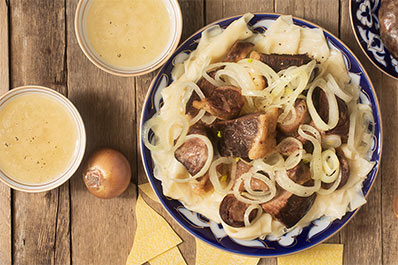Kazakhstan Travel Guide
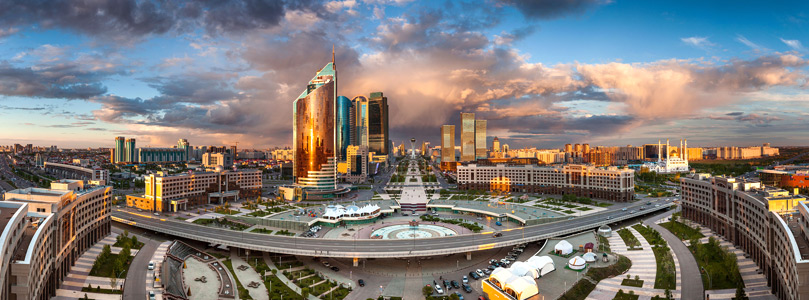
Kazakhstan, where ancient traditions and modernity coexist in harmony, is located at the center of Eurasia. The country is famous for its endless southern steppes, mountains and lakes, Baikonur Cosmodrome and the heritage of the Great Silk Road. Tourists who come to Kazakhstan will have no shortage of activities to choose from: historical trips, hunting, fishing, mountain climbing, ecotours and much more.
Kazakhstan is one of the most developed countries in the post-Soviet world. The futuristic capital Astana, designed by Norman Foster and other world-renowned architects, delights the eye in its scope and structure. At the same time, travelers can discover the untouched nature of Kazakhstan’s remote regions: ancient ruins, deserts and pristine alpine landscapes.
Our Kazakhstan Travel Guide will help to acquaint you with this beautiful country.
General information about Kazakhstan
Capital: Astana
Area: 2,725,000 square kilometers (The 9th largest country in the world)
Population: 18.04 million
Languages: Kazakh (official language), Russian (used in government and state organizations, and for interethnic communication)
Religion: Islam - 70%, Christianity - 26%, other faiths - 4%
Electricity: 220V AC, 50 A ; standard double plug socket.
Time zone: + 6 hours.
Internet zone: .kz
International telephone code: +7
Currency: Tenge
How to travel to Kazakhstan
For most international tourists, the easiest way to get to Kazakhstan is via a flight to Astana or Almaty. Many international airlines operate flights to these cities from Europe, East Asia, Dubai, Turkey and Russia.
If you’re coming to Kazakhstan from Russia, travel by train can be a cheaper option, but be prepared for a one or two-day ride.
Kazakhstan can also be reached by car from neighboring countries. Almaty and Shymkent are near the borders with Uzbekistan, Kyrgyzstan and China, and from Russia you can reach the northern cities of Kazakhstan, including Astana. Not every land border is open to foreigners, so be sure to check your route thoroughly in advance.
When to visit Kazakhstan
Spring and autumn, when the weather is neither cold nor scorching hot, is considered the ideal time to visit Kazakhstan. Tourism packages are available year-round, however, and a winter trip to Kazakhstan can be a great option for skiing and snowboarding fanatics.
You may also want to schedule a visit to Kazakhstan during one of their national holidays. Come during the Navruz holiday (March 21-23) to participate in Shymkent’s citywide festivities or arrange to be at the "Voices of Asia" festival in August, held at Medeo outdoor skating rink near Almaty.
What to wear in Kazakhstan
The climate in Kazakhstan is continental, meaning it can be very cold in winter (particularly in the north) and very hot in summer (particularly in the south). Kazakhstan in December thru February can be particularly brutal for those unaccustomed to the cold, but the beauty of the snow-covered mountains and steppe can make a winter vacation well worth it!
Dress according to the season, remembering that occasional hot or cold fronts can hit at unexpected times.
Regardless of the time of year, at least one pair of comfortable shoes and a small umbrella are highly recommended.
If you plan a trip to the mountains, where it’s cool even in summer, plan to have a long-sleeve shirt and jacket, and full winter attire if you’ll be coming during the cold months.
You can show respect when visiting religious places by wearing conservative clothing in lieu of shorts, short skirts and sleeveless shirts.
As for style, most residents of Kazakhstan prefer modern, European-style clothing.
How to get a visa for Kazakhstan
Kazakhstan has a visa-free policy for citizens of many countries, including the US, Canada and many countries in Europe, Asia and the CIS. Under the visa-free guidelines you can stay in Kazakhstan for up to 30 days.
Citizens of countries for which a visa-free entrance is not granted should apply for a Kazakhstan visa through their nearest Kazakhstan embassy or consulate. Our Kazakhstan travel guide provides more complete visa information here.
Kazakhstan customs regulations
In general, customs is a quick and painless process when entering and exiting Kazakhstan.
Individuals can import or export cash in foreign and national currency, coins from precious metals and traveler's checks without customs declaration, provided the total amount is less than 10 thousand US dollars. Any amount exceeding this equivalent is subject to mandatory customs declaration.
To export antiques or items of significant cultural value you must have all the necessary documents ready to present at customs upon departure.
How many days to spend in Kazakhstan
There’s no lack of activities in Kazakhstan for the adventurous traveler, and we recommend spending as much time as possible in Kazakhstan so as not to be rushed in your tour of this huge country. Seven to ten days in Kazakhstan will give you the chance to venture out of Almaty into the national parks and less metropolitan areas, and a trip of two weeks or more will afford you a truly leisurely time.
Even if you only have a free day or two, however, a stopover in Almaty, Astana or Shymkent will be well worth your time.
Accommodation in Kazakhstan
The tourist infrastructure is fairly well developed in the larger cities of Kazakhstan. Almaty, Nur-Sultan and Shymkent have many hotels for every taste and budget, from ordinary two or three-star rooms to luxury hotels. In small cities, you may be limited to simpler accommodations or Soviet-style hotels.
Money and payment in Kazakhstan
The Kazakhstan national currency is the tenge. Changing dollars or euros to tenge should not be a problem in the cities, as exchange offices and bank branches are quite common.
In most places you’ll need to pay in tenge, although occasionally euros, dollars or even rubles may be accepted. When exchanging currency, keep in mind that most banks will only accept new, unmarked bills with few creases.
In major cities, Visa, MasterCard and American Express may be accepted in upscale and tourist areas. ATMs can be found in banks, hotels and shopping centers. However, the farther from major cities you venture, the more difficult it becomes to use debit or credit cards, so it’s advisable to have plenty of cash with you.
Food in Kazakhstan
No travel guide to Kazakhstan would be complete with information on the local food! The national cuisine of Kazakhstan consists of many recipes passed down through generations. An abundance of meat and flour products are the distinctive features of the Kazakh cuisine. Dairy drinks such as ayran, kumis (mare’s milk) and shubat (camel’s milk) are also very popular.
National Kazakh cuisine is very filling, often consisting of ample amounts of meat, dough and dairy products. The national dish, beshparmak, is made with large flat noodles, potatoes, onions broth and beef or horsemeat. Other popular dishes include manty (steamed dumplings filled with meat or potatoes), shashlik (meat kebabs), baursak (fried bread served especially on holidays), samsas (flaky, oven-baked pastries stuffed with onion, meat, cheese or potatoes) and kumis (sour mare’s milk).
In all large cities various cuisines can also be readily found, including European, Turkish and East Asian cafes.
Internet and phone service in Kazakhstan
Kazakhstan has four mobile operators in the GSM and UMTS format: Beeline, Kcell, Tele-2 and Altel.
To purchase a Kazakhstan SIM card, you are officially required to register your phone and present your passport upon purchase at an officially recognized service center for one of the above companies. However, this rule has not been strictly enforced, and SIM cards can still be purchased without passport or registration at various kiosks. SIM cards cost less than 5 USD.
In most hotels, restaurants and shopping complexes, Wi-Fi is now available. As internet access is monitored and certain blogs and social networks may be blocked, you should consider connecting to Wi-Fi through a VPN.
Healthcare in Kazakhstan
No vaccinations are required to enter Kazakhstan. Painkillers, antiseptics, bandages, plasters and cold medications are all widely available but may be of a different brand than Westerners are accustomed to and most travel guides for Kazakhstan recommend bringing your own. It’s advised that you bring an adequate supply of any prescription medications that you may need.
There are internationally recognized hospitals in Almaty and Nur-sultan. Healthcare is still poor in rural areas and in local clinics or hospitals English speakers may be scarce.
Since the local cuisine is quite heavy, you may want to have digestive tablets on hand while you adjust to the new food products.
Kazakhstan souvenirs and gifts
A variety of souvenirs, from trinkets to valuable paintings and ceramics, can be found in Kazakhstan. In addition to the standard magnets, key chains and t-shirts, various items of wood, porcelain and felt can make great gifts. Easy-to-transport items include Kazakh skullcaps and colorful headscarves, warm felt slippers and dolls in national Kazakh outfits, leather flasks and hand-sewn blankets. For larger gifts, consider a scenic painting of the Kazakh mountains or a teapot and teacups painted with traditional Kazakh designs.
For edible gifts, consider locally made chocolates wrapped to look like the Kazakh flag, horse sausage (kazi) or some dried salty cheese balls known as kurt, which receive mixed reviews among tourists but are wildly popular with Kazakhs.
Leaving Kazakhstan
Check that you have all your necessary documents – passport, immigration card and ticket – at easy reach before you leave for the airport.
Please remember that it’s very important to keep your immigration card, given to you upon entrance into the country, to present at border control.
If you have an international flight, it’s recommended to arrive at the airport 2-3 hours before departure. While lines are usually not very long at Kazakhstan’s airports, flights to most destinations usually do not leave more than once or twice per day. After arriving at the airport and checking in for your flight, you’ll go through customs and passport control.

